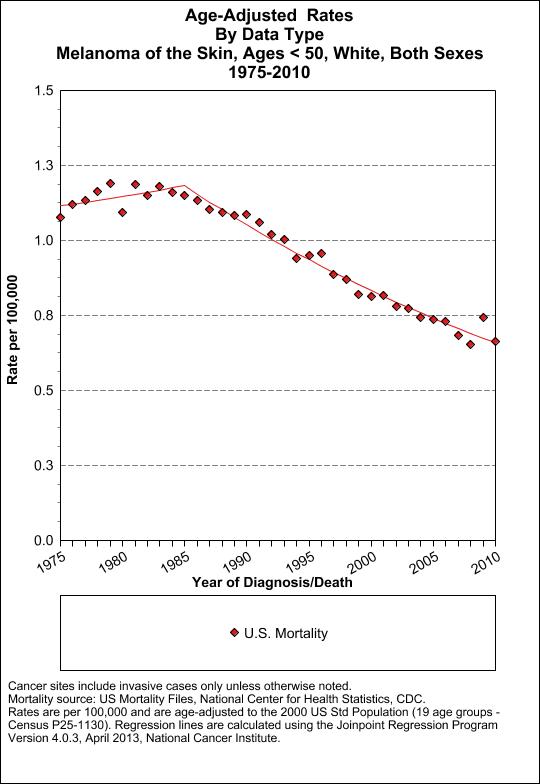Today’s tanning misinformation comes courtesy of the Sioux City Journal’s Dolly Butz.
In “It doesn’t pay to bask in the sun,” Ms. Butz tries to scare readers with the following:
[Melanoma] is the leading cause of cancer death among young adults ages 25-29.
Curious as to the source of this factoid, I first checked with the sunscreen-dermatologist industrial complex at SkinCancer.org. There I found only this:
Melanoma is the most common form of cancer for young adults 25-29 years old and the second most common form of cancer for adolescents and young adults 15-29 years old.
Note that SkinCancer.org only refers to incidence of melanoma — not death from melanoma. While melanoma is rare, death from melanoma is rarer still.
As SkinCancer.org cited the National Cancer Institute for its statement, I next went there to see if NCI had anything on melanoma and death among 25-29 year olds.
In the monograph “Cancer Epidemiology in Older Adolescents and Young Adults 15 to 29 Years of Age”, I found this chart show the incidence rates of various cancers among 25-29 year olds:
Note that while “invasive skin cancer” occurs marginally more often than lymphoma among 25-29 year olds (18% vs. 16%), only 70% of invasive skin cancers are melanoma. So melanoma is only 12.6% of cancers among 25-29 year olds — making lymphomas the most common cancer in the age group. Moreover, although cancers of the male and female genital tract are several, considering all cancers of the genital tract as a single group, they almost double the incidence of melanoma (23% vs. 12.6%).
Note, all this refers to melanoma incidence not mortality.
The NCI monograph summarizes the following (in relevant part) about melanoma mortality among young people:
Mortality and Survival
• As expected from the incidence patterns, the vast majority of deaths from melanoma among adolescents and young adults occurred in white, non-Hispanic patients.
• Mortality for malignant melanoma showed continued improvement over time in all age groups, but particularly in 20- to 29-year-olds.
• Melanoma in 10- to 39-year-olds was highly curable, with 5-year survival rates exceeding 90%.
• Females had a higher survival rate—exceeding 95% at five years among 15- to 29-year-olds — in comparison to males, who had an 88% 5-year survival rate during the past quarter century.
None of this supports Ms. Butz’s assertion about death from melanoma among 25-29 year olds.
A final and definitive comment about Ms. Butz’s scaremongering about sun exposure and melanoma can be found on page 54:
The etiology of melanoma in 15- to 29-year old individuals is not known.
It should be noted that the aforementioned monograph statistics are only from the period 1975-2000 though NCI has published melanoma incidence statistics through 2010. That said, NCI statistics indicate that melanoma death rates among whites under 50 have actually declined during 1975-2010.


I was a teen myself about the time that public perception was shifting from “tan, don’t burn” to “screen, don’t tan.” That was the early 70s and the melanoma death rate begins to fall soon thereafter. I doubt that there had yet been much change in behavior, though.
I would think that leukemia would be the leading cause of cancer deaths in people under 40 but maybe leukemia just gets all the noise. Considering the number of teens and twenties who get a lot of sun exposure, and the low rates of both melanoma and death from melanoma, it’s probably less important than the scolds are telling us.
That said, if I understand correctly, very severe sunburns occuring before age 20 have been linked to later development of melanoma. There’s a big gap between “don’t scorch, you twit” and “your vanity will cause you an early death”, though.